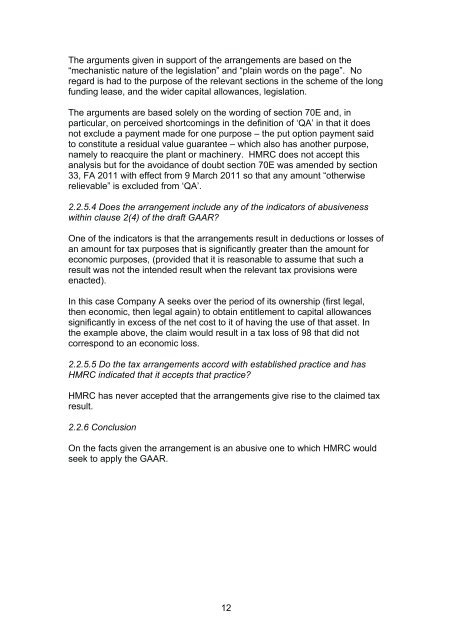Examples of how the GAAR applies to tax arrangements
Examples of how the GAAR applies to tax arrangements
Examples of how the GAAR applies to tax arrangements
You also want an ePaper? Increase the reach of your titles
YUMPU automatically turns print PDFs into web optimized ePapers that Google loves.
The arguments given in support <strong>of</strong> <strong>the</strong> <strong>arrangements</strong> are based on <strong>the</strong><br />
“mechanistic nature <strong>of</strong> <strong>the</strong> legislation” and “plain words on <strong>the</strong> page”. No<br />
regard is had <strong>to</strong> <strong>the</strong> purpose <strong>of</strong> <strong>the</strong> relevant sections in <strong>the</strong> scheme <strong>of</strong> <strong>the</strong> long<br />
funding lease, and <strong>the</strong> wider capital allowances, legislation.<br />
The arguments are based solely on <strong>the</strong> wording <strong>of</strong> section 70E and, in<br />
particular, on perceived shortcomings in <strong>the</strong> definition <strong>of</strong> ‘QA’ in that it does<br />
not exclude a payment made for one purpose – <strong>the</strong> put option payment said<br />
<strong>to</strong> constitute a residual value guarantee – which also has ano<strong>the</strong>r purpose,<br />
namely <strong>to</strong> reacquire <strong>the</strong> plant or machinery. HMRC does not accept this<br />
analysis but for <strong>the</strong> avoidance <strong>of</strong> doubt section 70E was amended by section<br />
33, FA 2011 with effect from 9 March 2011 so that any amount “o<strong>the</strong>rwise<br />
relievable” is excluded from ‘QA’.<br />
2.2.5.4 Does <strong>the</strong> arrangement include any <strong>of</strong> <strong>the</strong> indica<strong>to</strong>rs <strong>of</strong> abusiveness<br />
within clause 2(4) <strong>of</strong> <strong>the</strong> draft <strong>GAAR</strong>?<br />
One <strong>of</strong> <strong>the</strong> indica<strong>to</strong>rs is that <strong>the</strong> <strong>arrangements</strong> result in deductions or losses <strong>of</strong><br />
an amount for <strong>tax</strong> purposes that is significantly greater than <strong>the</strong> amount for<br />
economic purposes, (provided that it is reasonable <strong>to</strong> assume that such a<br />
result was not <strong>the</strong> intended result when <strong>the</strong> relevant <strong>tax</strong> provisions were<br />
enacted).<br />
In this case Company A seeks over <strong>the</strong> period <strong>of</strong> its ownership (first legal,<br />
<strong>the</strong>n economic, <strong>the</strong>n legal again) <strong>to</strong> obtain entitlement <strong>to</strong> capital allowances<br />
significantly in excess <strong>of</strong> <strong>the</strong> net cost <strong>to</strong> it <strong>of</strong> having <strong>the</strong> use <strong>of</strong> that asset. In<br />
<strong>the</strong> example above, <strong>the</strong> claim would result in a <strong>tax</strong> loss <strong>of</strong> 98 that did not<br />
correspond <strong>to</strong> an economic loss.<br />
2.2.5.5 Do <strong>the</strong> <strong>tax</strong> <strong>arrangements</strong> accord with established practice and has<br />
HMRC indicated that it accepts that practice?<br />
HMRC has never accepted that <strong>the</strong> <strong>arrangements</strong> give rise <strong>to</strong> <strong>the</strong> claimed <strong>tax</strong><br />
result.<br />
2.2.6 Conclusion<br />
On <strong>the</strong> facts given <strong>the</strong> arrangement is an abusive one <strong>to</strong> which HMRC would<br />
seek <strong>to</strong> apply <strong>the</strong> <strong>GAAR</strong>.<br />
12

















